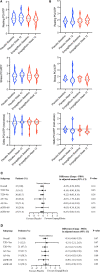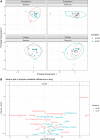Assessment of Cardiac Energy Metabolism, Function, and Physiology in Patients With Heart Failure Taking Empagliflozin: The Randomized, Controlled EMPA-VISION Trial
- PMID: 37070436
- PMCID: PMC10212585
- DOI: 10.1161/CIRCULATIONAHA.122.062021
Assessment of Cardiac Energy Metabolism, Function, and Physiology in Patients With Heart Failure Taking Empagliflozin: The Randomized, Controlled EMPA-VISION Trial
Abstract
Background: Sodium-glucose co-transporter 2 inhibitors (SGLT2i) have emerged as a paramount treatment for patients with heart failure (HF), irrespective of underlying reduced or preserved ejection fraction. However, a definite cardiac mechanism of action remains elusive. Derangements in myocardial energy metabolism are detectable in all HF phenotypes, and it was proposed that SGLT2i may improve energy production. The authors aimed to investigate whether treatment with empagliflozin leads to changes in myocardial energetics, serum metabolomics, and cardiorespiratory fitness.
Methods: EMPA-VISION (Assessment of Cardiac Energy Metabolism, Function and Physiology in Patients With Heart Failure Taking Empagliflozin) is a prospective, randomized, double-blind, placebo-controlled, mechanistic trial that enrolled 72 symptomatic patients with chronic HF with reduced ejection fraction (HFrEF; n=36; left ventricular ejection fraction ≤40%; New York Heart Association class ≥II; NT-proBNP [N-terminal pro-B-type natriuretic peptide] ≥125 pg/mL) and HF with preserved ejection fraction (HFpEF; n=36; left ventricular ejection fraction ≥50%; New York Heart Association class ≥II; NT-proBNP ≥125 pg/mL). Patients were stratified into respective cohorts (HFrEF versus HFpEF) and randomly assigned to empagliflozin (10 mg; n=35: 17 HFrEF and 18 HFpEF) or placebo (n=37: 19 HFrEF and 18 HFpEF) once daily for 12 weeks. The primary end point was a change in the cardiac phosphocreatine:ATP ratio (PCr/ATP) from baseline to week 12, determined by phosphorus magnetic resonance spectroscopy at rest and during peak dobutamine stress (65% of age-maximum heart rate). Mass spectrometry on a targeted set of 19 metabolites was performed at baseline and after treatment. Other exploratory end points were investigated.
Results: Empagliflozin treatment did not change cardiac energetics (ie, PCr/ATP) at rest in HFrEF (adjusted mean treatment difference [empagliflozin - placebo], -0.25 [95% CI, -0.58 to 0.09]; P=0.14) or HFpEF (adjusted mean treatment difference, -0.16 [95% CI, -0.60 to 0.29]; P=0.47]. Likewise, there were no changes in PCr/ATP during dobutamine stress in HFrEF (adjusted mean treatment difference, -0.13 [95% CI, -0.35 to 0.09]; P=0.23) or HFpEF (adjusted mean treatment difference, -0.22 [95% CI, -0.66 to 0.23]; P=0.32). No changes in serum metabolomics or levels of circulating ketone bodies were observed.
Conclusions: In patients with either HFrEF or HFpEF, treatment with 10 mg of empagliflozin once daily for 12 weeks did not improve cardiac energetics or change circulating serum metabolites associated with energy metabolism when compared with placebo. Based on our results, it is unlikely that enhancing cardiac energy metabolism mediates the beneficial effects of SGLT2i in HF.
Registration: URL: https://www.
Clinicaltrials: gov; Unique identifier: NCT03332212.
Keywords: empagliflozin; heart failure; magnetic resonance spectroscopy; sodium-glucose transporter proteins.
Conflict of interest statement
Figures




References
-
- Mamas MA, Sperrin M, Watson MC, Coutts A, Wilde K, Burton C, Kadam UT, Kwok CS, Clark AB, Murchie P, et al. Do patients have worse outcomes in heart failure than in cancer? A primary care-based cohort study with 10-year follow-up in Scotland. Eur J Heart Fail. 2017;19:1095–1104. doi: 10.1002/ejhf.822 - PubMed
-
- Maddox TM, Januzzi JL, Jr, Allen LA, Breathett K, Butler J, Davis LL, Fonarow GC, Ibrahim NE, Lindenfeld J, Masoudi FA, et al. ; Writing Committee. 2021 update to the 2017 ACC expert consensus decision pathway for optimization of heart failure treatment: answers to 10 pivotal issues about heart failure with reduced ejection fraction: a report of the American College of Cardiology solution set oversight committee. J Am Coll Cardiol. 2021;77:772–810. doi: 10.1016/j.jacc.2020.11.022 - PubMed
-
- Zinman B, Wanner C, Lachin JM, Fitchett D, Bluhmki E, Hantel S, Mattheus M, Devins T, Johansen OE, Woerle HJ, et al. ; EMPA-REG OUTCOME Investigators. Empagliflozin, cardiovascular outcomes, and mortality in type 2 diabetes. N Engl J Med. 2015;373:2117–2128. doi: 10.1056/NEJMoa1504720 - PubMed
-
- Packer M, Anker SD, Butler J, Filippatos G, Pocock SJ, Carson P, Januzzi J, Verma S, Tsutsui H, Brueckmann M, et al. ; EMPEROR-Reduced Trial Investigators. Cardiovascular and renal outcomes with empagliflozin in heart failure. N Engl J Med. 2020;383:1413–1424. doi: 10.1056/NEJMoa2022190 - PubMed
Publication types
MeSH terms
Substances
Associated data
Grants and funding
LinkOut - more resources
Full Text Sources
Medical
Research Materials
Miscellaneous

